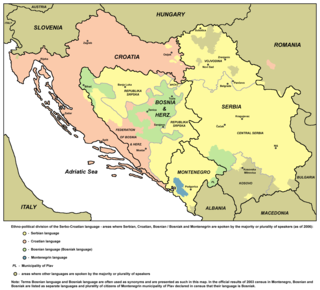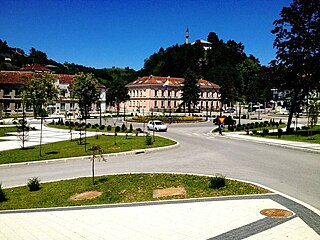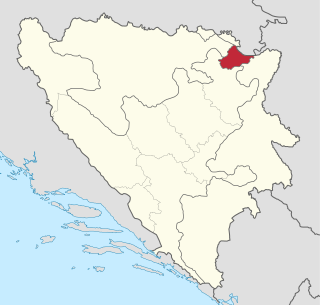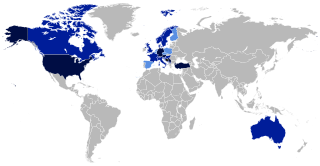Overall
| Type | Number | Percentage | Number change | Percentage change |
|---|---|---|---|---|
| Orthodox Christians | 571,250 | 42.76% | ||
| Sunni Muslims | 492,710 | 36.88% | ||
| Catholics | 265,788 | 19.89% | ||
| Jews | 5,805 | 0.43% | ||
| Others | 538 | 0.04% |
Population of Bosnia and Herzegovina in 1885
The 1885 population census in Bosnia and Herzegovina was the second census of the population of Bosnia and Herzegovina taken during the Austro-Hungarian occupation. [1] [2]
| Type | Number | Percentage | Number change | Percentage change |
|---|---|---|---|---|
| Orthodox Christians | 571,250 | 42.76% | ||
| Sunni Muslims | 492,710 | 36.88% | ||
| Catholics | 265,788 | 19.89% | ||
| Jews | 5,805 | 0.43% | ||
| Others | 538 | 0.04% |

Bosnia and Herzegovina, abbreviated BiH or B&H, sometimes called Bosnia–Herzegovina and often known informally as Bosnia, is a country at the crossroads of south and southeast Europe, located in the Balkans. The capital and largest city is Sarajevo. Bosnia and Herzegovina borders Serbia to the east, Montenegro to the southeast, and Croatia to the north and southwest. It is not entirely landlocked; in the south it has a narrow coast on the Adriatic Sea within the Mediterranean, which is about 20 kilometres long and surrounds the town of Neum. Bosnia, which is the inland region of the country, has a moderate continental climate with hot summers and cold, snowy winters. In the central and eastern regions of the country, the geography is mountainous, in the northwest it is moderately hilly, and in the northeast it is predominantly flat. Herzegovina, which is the smaller, southern region of the country, has a Mediterranean climate and is mostly mountainous.

This article is about the demographic features of the population of Bosnia and Herzegovina, including population density, ethnicity, education level, health of the populace, economic status, religious affiliations and other aspects of the population.

Sarajevo is the capital and largest city of Bosnia and Herzegovina, with a population of 275,524 in its administrative limits. The Sarajevo metropolitan area including Sarajevo Canton, East Sarajevo and nearby municipalities is home to 555,210 inhabitants. Located within the greater Sarajevo valley of Bosnia, it is surrounded by the Dinaric Alps and situated along the Miljacka River in the heart of the Balkans, a region of Southern Europe.

Bosnian is the standardized variety of the Serbo-Croatian pluricentric language mainly used by ethnic Bosniaks. Bosnian is one of three such varieties considered official languages of Bosnia and Herzegovina, along with Croatian and Serbian. It is also an officially recognized minority language in Croatia, Serbia, Montenegro, North Macedonia and Kosovo.

Republika Srpska is one of the two entities of Bosnia and Herzegovina, the other being the Federation of Bosnia and Herzegovina. It is located in the north and east of the country. Its largest city and administrative centre is Banja Luka, lying on the Vrbas river.

The Federation of Bosnia and Herzegovina is one of the two entities within the State of Bosnia and Herzegovina, the other being Republika Srpska. The Federation of Bosnia and Herzegovina consists of 10 autonomous cantons with their own governments and legislatures.

Ploče is a town and seaport in the Dubrovnik-Neretva County of Croatia.

Cazin is a city located in Una-Sana Canton of the Federation of Bosnia and Herzegovina, an entity of Bosnia and Herzegovina. It is situated in northwest Bosnia and Herzegovina in the Bosanska Krajina region, near the border with Croatia. As of 2013, it has a population of 66,149 inhabitants.

Brčko District officially the Brčko District of Bosnia and Herzegovina, is the self-governing administrative unit in north-eastern Bosnia and Herzegovina.

This article is about the Demographic history of Bosnia and Herzegovina, and deals with the country's documented demographics over time. For an overview of the various ethnic groups and their historical development, see Ethnic groups in Bosnia and Herzegovina.

Breza is a town and municipality located in Zenica-Doboj Canton of the Federation of Bosnia and Herzegovina, an entity of Bosnia and Herzegovina. It is situated in central Bosnia and Herzegovina, and is famous for mining and production of coal. It covers an area of 73 km2 (28 sq mi).

Bosniaks or Bosniacs are a South Slavic ethnic group native to the Southeast European historical region of Bosnia, which is today part of Bosnia and Herzegovina.

The Turks in Bosnia and Herzegovina also known as Bosnian Turks, are ethnic Turks who form the oldest ethnic minority in Bosnia and Herzegovina. The Turkish community began to settle in the region in the 15th century under Ottoman rule, however many Turks emigrated to Turkey when Bosnia and Herzegovina came under Austro-Hungarian rule.
Sandići is a village in the municipality of Brčko, Bosnia and Herzegovina. František Pubička, Czech Jesuit, bohemian historian and dean of the Faculty of Philosophy in his extensive work Chronological history of Bohemia under the Slavs published in the original in German and titled: " 1770–1801:Chronologische geschichte Böhmens." cites the place as "an early Slavic settlement and town of the Sandići noble family with relatives in a fortified city of Bobovac."
Trge is a village in the municipality of Bugojno, Bosnia and Herzegovina. According to the 2013 Bosnian census, there are no inhabitants of Trge.
The most recent census of Bosnia and Herzegovina, the 2013 census, took place from 1 October until 15 October 2013 with a reference date of census 30 September 2013 at 24:00 hours (midnight), 22 years after the previous census. It was the first census after the Bosnian War. It was organized by the Central Census Bureau of Bosnia and Herzegovina and supported by the European Union.
The 1879 population census in Bosnia and Herzegovina was the first census of the population of Bosnia and Herzegovina taken during the Austro-Hungarian occupation.

The 1895 population census in Bosnia and Herzegovina was the third census of the population of Bosnia and Herzegovina taken during the Austro-Hungarian occupation
The 1910 population census in Bosnia and Herzegovina was the fourth census of the population of Bosnia and Herzegovina taken during the Austro-Hungarian Condominium of Bosnia and Herzegovina

The Albanians of Bosnia and Herzegovina are people of full or partial Albanian ancestry and heritage in Bosnia and Herzegovina.